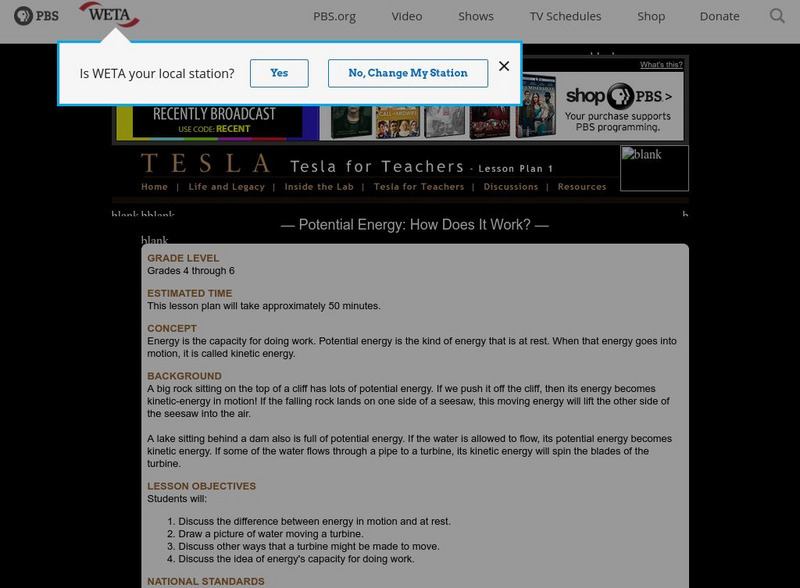Carnegie Mellon University
Understanding Electricity Mix Tradeoffs
Use the accompanying presentation and colorful technology sheets to introduce your class to the 10 different energy technologies. Connect kids to an interactive computer tool that allows them to combine different types of power...
Curated OER
Itaipu Dam and Power Plant (Brazil and Paraguay)
Learners study South America's Itaipu Dam and Power Plant in order to gain an understanding that hydroelectric power is a major means of generating electricity throughout the world. They also look into the environmental impacts that...
Curated OER
The Price of Power
Explore the current political debate over regulating power plant emissions. Critical thinkers research, formulate, and present arguments regarding selective catalytic reduction systems for coal-burning plants.
College Board
2000 AP® Environmental Science Free-Response Questions
Practice makes perfect! A released AP® exam gives scholars practice with the high level of expectations of their exams. The exam consists of four questions from 2000. Questions ask about endangered species, recycling, alternative fuels,...
College Board
2004 AP® Environmental Science Free-Response Questions
Radioactive isotopes have a wealth of uses, but their waste may cause some concern. One of four free-response questions challenges learners to devise a waste removal strategy for medical radioactive substances. Other questions address...
Kenan Fellows
Electricity: Sources, Usage, Challenges, and the Future
What does the future of energy look like? Junior engineers collaborate to discover a solution to the global energy crisis during a very hands-on instructional activity. The unit focuses on learning through collaboration to develop a deep...
CK-12 Foundation
Power Lines
How does electricity travel through power lines? The simulation demonstrates the how changes in voltage and resistance are related to the distance between power polls and the thickness of the cable. Scholars control three variables in...
Wind Wise Education
Understanding Electric Power Generation
You mean the electricity does not come from the switch? As a class and in small groups, learners explore the sources of energy used to generate electric power. Worksheets guide groups into choosing a future electricity generating...
Carnegie Mellon University
How Power Plants Work 3
Double, double toil and trouble, fire burn and cauldron bubble! Find out what drives a turbine to generate electricity and whether or not it has an impact on the environment. A discussion and lecture is divided by a hands-on activity in...
Curated OER
Nuclear Energy
Atomic theory as a philosophical study was explored even by the Ancient Greeks. The knowledge of atoms was developed in the 17th century. This PowerPoint explains how by the 1940's, splitting of the atom was discovered and since then,...
Curated OER
Electricity
In this electricity worksheet, students review scientists and inventors of electricity. how electricity is transported, and how electricity is measured. This worksheet has 16 problems to solve, 5 fill in the blank, and 7 short answer...
Curated OER
Who's Got Your Power
Students examine and map local sources of energy. They conduct Internet research on their local utility company, identify where their utility company obtains energy, graph the data, and label a map of power plant locations in their state.
Curated OER
Energy Panel Hearings: "Your Town", Saskatchewan
Tenth graders access information to participate in a debate about whether a power plant should be placed in their town. They research an assigned point of view.
TeachEngineering
Teach Engineering: Rolling Blackouts & Environmental Impact
The goal is for the students to understand the environmental design considerations required when generating electricity. The electric power that we use every day at home and work is generated by a variety of power plants. Power plants...
National Academy of Engineering
Greatest Engineering Achievements of the Twentieth Century: Nuclear Technologies
Students learn about nuclear technologies in the 20th century. Some topics explored are splitting the atom, the Manhattan Project, and power plants. The resource includes historical information, a timeline, and a personal essay by a key...
PBS
Pbs Teachers: Potential Energy: How Does It Work?
Describe the difference between energy in motion and at rest, and demonstrate energy's capacity for doing work. Draw a picture of water moving a turbine, and discuss other ways that a turbine might be made to move.
CK-12 Foundation
Ck 12: Physical Science: Electrical Grid
[Free Registration/Login may be required to access all resource tools.] Explains what an electrical grid is and the role of power plants, transmission lines, and electric substations.
US Energy Information Administration
U.s. Eia: Energy Kids: Renewable Energy: Solar
This is a resource on solar energy, photovoltaic energy, solar thermal heat, solar thermal power plants and other forms of energy.
PBS
Pbs Teachers: Scientific American: Dragon Science: Dams and Dolphins
Explore environmental impact of building of a dam in China's Yangtze River on endangered fresh water dolphins. Observe the presence and effects of osmotic pressure, measure and compare sedimentation in a waterway and build a turbine.
NASA
Climate Kids: Be a Power Saver
Do you ever wonder where electricity comes from? Discover the process of how power plants create energy and it ends up at the touch of your fingertips.
Ducksters
Ducksters: Physics for Kids: Nuclear Energy and Fission
Kids learn about nuclear energy and fission in the science of physics including E=mc2, power plants, uses of nuclear power, and fusion.






















